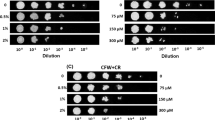Summary
Visible light influences sporulation in two different ways: a) by completely blocking ascospore formation in a varying percentage of the cells dependent on the intensity and duration of illumination, and b) by delaying the onset of sporulation. Blue light (400–500 nm) is found to be responsible for both these effects while red light (600–700 nm) is ineffective. The first effect of light i.e. the inhibition of ascospore formation seems to be nonspecific. There is e.g. no specific effect on meiosis, since the inhibition of sporulation is the same whether the illumination is given during the premeiotic period or during the meiotic and postmeiotic period. The inhibition is twice as high when the cells have been illuminated during both periods. The extent of inhibition is independent of the length of the preculture. On the other hand, the second effect of light (delay of sporulation onset) is stronger with cells from the first phase than with those from the second phase of exponential growth. This effect seems to be concerned with processes of assimilation of C2-compounds such as ethanol (preculture) or acetate (sporulation culture), respectively, but it has nothing or almost nothing to do with the oxidation of these compounds. This is concluded from the following results: only little inhibition of O2-consumption, light-induced suppression of the second growth phase of the preculture and inhibition of the growth which normally occurs during the first hours in the sporulation medium. The inhibition of ethanol or acetate assimilation is only partly explained by the comparably small light-induced decline of the activity of glyoxylate cycle enzymes.
Zusammenfassung
Die Ascosporenbildung wird durch sichtbares Licht in zweifacher Weise beeinflußt, a) durch Blockierung der Ascusbildung in einem Teil der Zellen (= 1. Lichteffekt) und b) durch Verzögerung des Sporulationsbeginns (=2. Lichteffekt). Der wirksame Spektralbereich im sichtbaren Bereich des Spektrums liegt bei Wellenlängen um 400–500 nm, während Rotlicht keinen Einfluß ausübt. Der 1. Lichteffekt (Hemmung der Sporulation) ist anscheinend unspezifischer Natur, betrifft z. B. nicht spezifisch die Meiose, da Licht während der vormeiotischen Periode der Sporulationskultur gleich stark wirkt wie Licht, das erst während und nach der Meiose eingestrahlt wird. Bei Belichtung beider Abschnitte wird etwa die doppelte Wirkung erzielt. Das Ausmaß der Hemmung ist unabhängig von der Dauer der Vorkultur. Dagegen ist der 2. Lichteffekt (Verzögerung des Sporulations-beginns) stärker bei Zellen aus der 1. Vermehrungsphase der Vorkultur als bei solchen aus der zweiten und betrifft offenbar Prozesse, die mit der Assimilation, nicht aber mit der Oxidation von C2-Körpern wie Äthanol (Vorkultur) bzw. Acetat (Sporulationskultur) zusammenhängen. Dies wird aus folgenden Ergebnissen geschlossen: nur geringfügige Hemmung der O2-Aufnahme, Möglichkeit der Unterdrückung der 2. Vermehrungsphase durch Belichtung der Vorkultur und lichtbedingte Hemmung des in der Anfangsphase der Sporulationskultur erfolgenden Wachstums. Die Hemmung der Äthanol-bzw. Acetatassimilation läßt sich jedoch nicht oder nicht allein aus einer nur vergleichsweise geringen lichtinduzierten Aktivitätserniedrigung der Glyoxylatcyclusenzyme erklären.
Similar content being viewed by others
Literatur
Beisenherz, G., Boltze, H. J., Bücher, T. H., Czok, R., Garbade, K. H., Meyer-Arendt, E., Pfleiderer, G.: Diphosphofructose-Aldolase, Phosphoglyceraldehyd-Dehydrogenase, Milchsäure-Dehydrogenase, Glycerophosphat-Dehydrogenase und Pyruvat-Kinase aus Kaninchenmuskulatur in einem Arbeitsgang. Z. Naturforsch. 8b, 555–577 (1953).
Dixon, G. H., Kornberg, H. L.: Assay methods for key enzymes of the glyoxylate cycle. Biochem. J. 72, 3 P (1959).
Ehrenberg, M.: Der Phosphorstoffwechsel von Saccharomyces cerevisiae in Abhängigkeit von intra-und extracellulärer Phosphatkonzentration. Arch. Mikrobiol. 40, 126–152 (1961).
Ehrenberg, M.: Wirkungen sichtbaren Lichtes auf Saccharomyces cerevisiae. I. Einfluß verschiedener Faktoren auf die Höhe des Lichteffektes bei Wachstum und Stoffwechsel. Arch. Mikrobiol. 54, 358–373 (1966a).
Ehrenberg, M.: Wirkungen sichtbaren Lichtes auf Saccharomyces cerevisiae. II. Die Gärung unter dem Einfluß von Pasteur-Effekt und Licht-Effekt. Arch. Mikrobiol. 55, 26–30 (1966b).
Ehrenberg, M.: Die Höhe des Lichteffekts auf Wachstum und Stoffwechsel von Saccharomyces cerevisiae in Abhängigkeit vom Phasenstatus der Vorkulturzellen. Arch. Mikrobiol. 61, 20–29 (1968).
Halbach-Keup, G., Ehrenberg, M.: Einfluß des Phasenstatus der Vorkulturzellen auf die Ascosporenbildung von Saccharomyces cerevisiae. Arch. Mikrobiol. 78, 17–24 (1971).
Kelly, M. S., Gay, J. L.: The action of visible radiation on the formation and properties of Saccharomyces ascospores. Arch. Mikrobiol. 66, 259–272 (1969).
Keup, G.: Die Ascosporenbildung von Saccharomyces cerevisiae in Abhängigkeit von der Vorkultur und unter dem Einfluß sichtbaren Lichtes. Diss., Würzburg 1967.
Kohlhaw, G., Drägert, W., Holzer, H.: Parallel-Repression der Synthese von Glutamin-Synthetase und DPN-abhängiger Glutamat-Dehydrogenase in Hefe. Biochem. Z. 341, 224–238 (1965).
Mäder, L. R.: Über Diauxie im Hefewachstum. Diss., ETH Zürich 1967.
Oppenoorth, W. F. F.: The sporulation of brewing yeasts. Proc. 5th. Eur. Brew. Conv., 222–240 (1957).
Pontefract, R. D., Miller, J. J.: The metabolism of yeast sporulation. IV. Cytological and physiological changes in sporulating cells. Canad. J. Microbiol. 8, 573–584 (1962).
Purvis, J. E., Warwick, G. R.: The influence of spectral colours on the sporulation of Saccharomyces. Proc. Camb. phil. Soc. biol. Sci. 14, 30–40 (1908).
Santarius, K.: Untersuchungen über die Ursache der Erhöhung der Trockenresistenz bei Bäckerhefe nach Adaptation an hypertonische Lösungen. Diss., Würzburg 1961.
Sulkowski, E., Guerin, B., Defaye, J., Slonimski, P. P.: Inhibition of protein synthesis in yeast by low intensities of visible light. Nature (Lond.) 202, 36–39 (1964).
Author information
Authors and Affiliations
Rights and permissions
About this article
Cite this article
Ehrenberg, M., Halbach-Keup, G. & Gerth, H. Untersuchungen zur lichtinduzierten Hemmung der Ascosporenbildung bei Saccharomyces cerevisiae . Archiv. Mikrobiol. 90, 233–246 (1973). https://doi.org/10.1007/BF00424975
Received:
Issue Date:
DOI: https://doi.org/10.1007/BF00424975




